1st Monitoring
The first monitoring was implemented individually by quality assurance agencies in Japan, China, and Korea, based on each nation's relevant domestic regulations, evaluation systems, and methods. Moreover, after the monitoring, the agencies shared their results for a comparative analysis, and discussed the possibility of conducting a second monitoring, in cooperation with all three countries.
The first monitoring in Japan was conducted by NIAD-UE from 2013‒2014, in cooperation with the Japanese universities running 'CAMPUS Asia' pilot programs. In line with the basic concept of the first monitoring outlined below, NIAD-UE summarized the details of the monitoring criteria and methods, in the Handbook for 'CAMPUS Asia' Monitoring - Criteria and Method of the 1st Monitoring in Japan.![]()
- Based on the criteria determined by NIAD-UE, the universities that offer exchange programs first analyze the current state of their programs themselves (production of self-analysis reports). The monitoring committees identify the programs' good practices for quality assurance and effective measures to resolve the challenges of international exchange programs, through self-analysis reports.
- The self-analysis reports should include matters on which the program implementers wish to seek input from the monitoring committees. Thus, it is expected to improve quality, through exchanges of opinions and advice.
- Monitoring Procedure
- Monitoring Criteria
- Implementation Structure
- Monitoring Student Committee
- Monitoring Reports
- A Collection of Good Practices
Monitoring Procedure
The first monitoring in Japan was implemented as shown in the figure below.
For the first monitoring in Japan, a student monitoring committee was established, which was separate from the main monitoring committee and other subcommittees. It comprised students who had participated in 'CAMPUS Asia' programs. For details, please see Monitoring Student Committee.
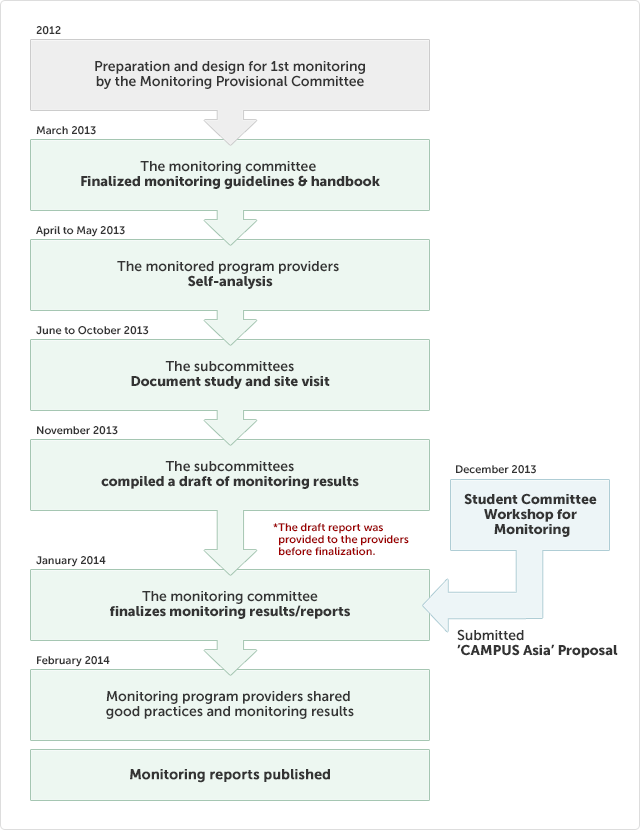
Monitoring Criteria
The criteria for the first monitoring in Japan, as shown in the table below, were established by the monitoring committee, based on several discussions within the provisional monitoring committee, organized by NIAD-UE. These criteria also reflected the opinions exchanged with participating universities through liaison meetings and individual interviews. All the monitoring activities including self-analysis, document analysis, and site visits conducted, were based on these criteria.
| Criteria |
|---|
| 1 Goals of the Academic Program |
| 2 Teaching and Learning 2-1 Organization and Staff 2-2 Contents of Academic Program 2-3 Support for Learning and Living 2-4 Credit Transfer and Grading System |
| 3 Learning Outcomes |
| 4 Internal Quality Assurance System |
Each criterion provides "examples of good practices," allowing universities' self-analysis to include their own successful practices and effective measures for resolving problems in international exchange programs. In addition, a rubric for a self-analysis of the quality level is introduced for each criterion.
Implementation Structure
'CAMPUS Asia' Monitoring Committee and Subcommittees
To implement the first monitoring, NIAD-UE organized a 'CAMPUS Asia' monitoring committee, and subcommittees comprising of academics and experts, with experience and knowledge of quality assurance in higher education/international collaborative programs.
The monitoring committee was comprised of eight members, and its main role was to decide on monitoring criteria and methods, as well as to finalize the monitoring results. Moreover, two representatives of the participating program were included in the committee. This approach allowed them to express their perspectives, through discussions on disseminating the monitoring outcomes.
The subcommittees performed document analysis, site visits, and drafting of monitoring reports, based on the self-analysis reports submitted by universities. The subcommittees were composed of university presidents, faculty, and experts from university-related organizations and industries.
Liaison Meetings for the 'CAMPUS Asia' Programs
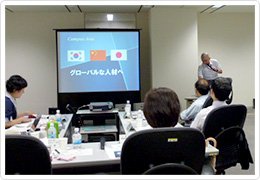
One of the characteristics of the first monitoring in Japan, was the liaison meetings for universities offering 'CAMPUS Asia' programs which were organized during the preparatory stage. These liaison meetings consisted of university representatives, from the ten 'CAMPUS Asia' programs in Japan.
The meetings were established to exchange views and opinions between NIAD-UE and the universities (program implementers) to enhance the effectiveness of monitoring implementation. Through this exchange of opinions, the liaison meetings supported the development of a basic framework, for the monitoring and criteria of quality-assured international collaborative education. Moreover, from the viewpoint of enhancing the effectiveness of the 'CAMPUS Asia' project itself, the meetings also intended to provide opportunities for universities, to share operational challenges, resolutions, and information regarding their programs' progress.
Three liaison meetings were held in July and September 2012, and March 2013, prior to the start of the monitoring process. Furthermore, after finalization of the monitoring results, a fourth meeting was held in February 2014, at which those involved in participating programs shared the results of the first monitoring, and exchanged views on those results.
Monitoring Student Committee
Student Engagement in 'CAMPUS Asia' Monitoring
During the first monitoring in Japan, apart from the monitoring committee and subcommittees, a monitoring student committee was established, with students who had participated in different 'CAMPUS Asia' programs. The purpose of this student committee was to encourage students to freely exchange their opinions across university boundaries from the perspective of promoting student engagement in external quality assurance. The committee also aimed to collect students' opinions on how to further improve the 'CAMPUS Asia' project, and provide feedback to the monitoring committees.
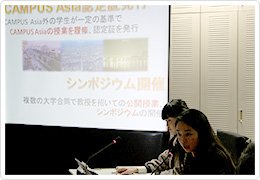
The monitoring student committee held a workshop in December 2013, to create more attractive 'CAMPUS Asia' programs for all students. At the workshop, 19 students from Japan, China, and Korea engaged in group work and discussions, and compiled the 'CAMPUS Asia' proposal. This proposal outlined the strengths and areas for improvement, both in terms of learning and living, based on the students' experience of program participation, and provided suggestions from the student committee.
This proposal was presented to the monitoring committee in January 2014, by the student committee representatives. The monitoring committee utilized their opinions in the second monitoring of 'CAMPUS Asia.'
Monitoring Reports
A monitoring report was compiled by the monitoring committee for each program, comprising overall conclusion and results for each criterion. Within the results for each criterion, "initiative characteristics" and "good practices," identified from the viewpoint of the quality of education, were presented. In addition, to contribute to the future development of the programs, the reports included comments from the monitoring committee members, regarding future challenges listed by the universities.
The self-analysis by universities initially covered activities up until the end of the 2012 academic year. However, given that the pilot programs entered their third year in the 2013 academic year, and student exchange was becoming full-fledged, the subcommittees also conducted monitoring activities in the 2013 academic year, and included these results in the reports.
Comprehensive Report of the 1st 'CAMPUS Asia' Monitoring in Japan
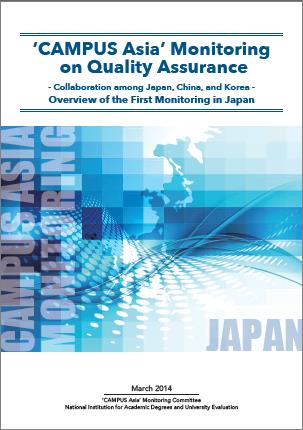
'CAMPUS Asia' Monitoring on Quality Assurance -Collaboration among Japan, China, and Korea- Overview of the First Monitoring in Japan
('CAMPUS Asia' Monitoring Committee of NIAD-UE, March 2014)
Alongside an outline of monitoring activities with criteria, it includes the monitoring reports for each of the 10 programs, the proposals submitted by the monitoring student committee, and summaries of the self-analysis reports.
A Collection of Good Practices
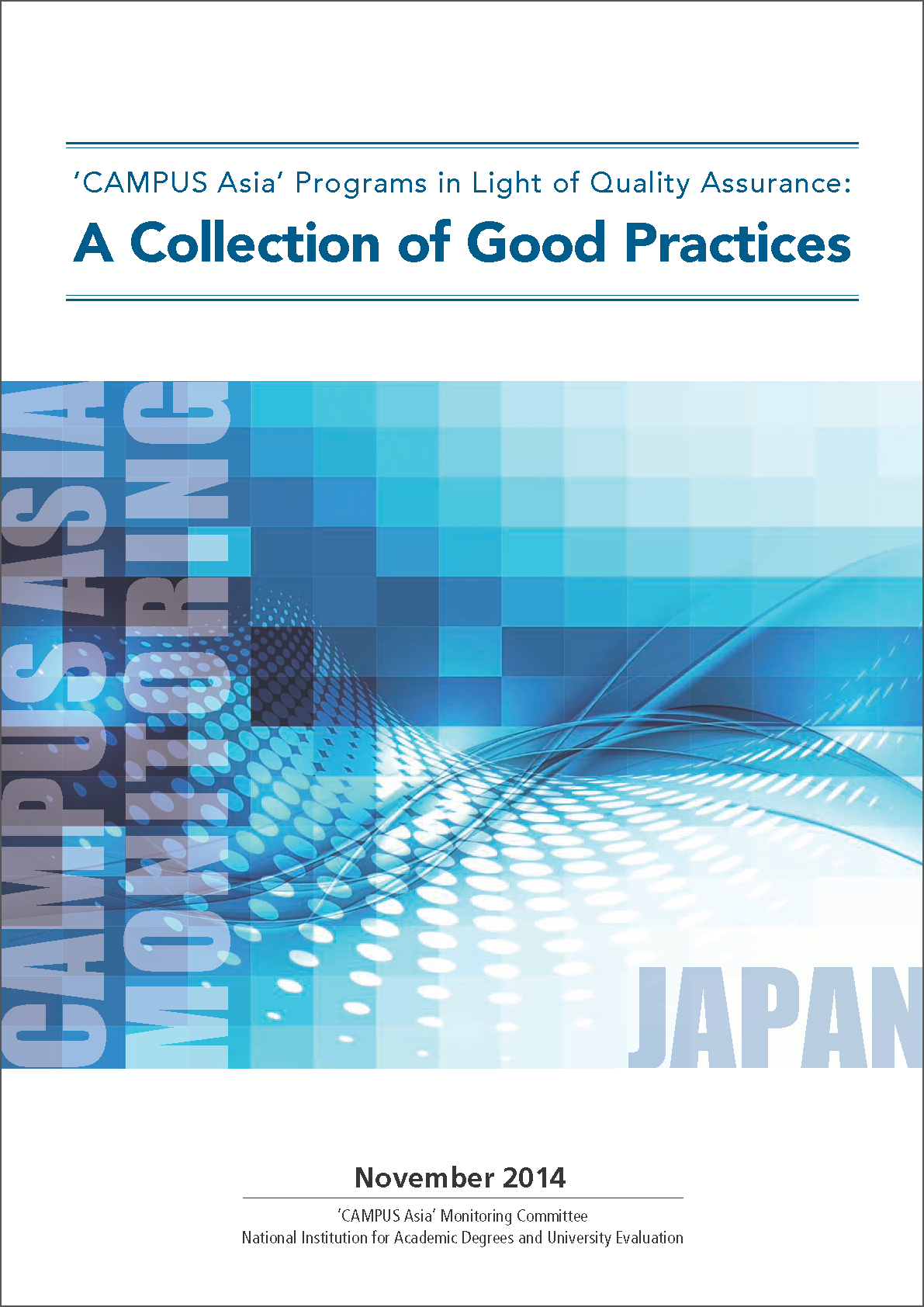
'CAMPUS Asia' Programs in Light of Quality Assurance : A Collection of Good Practices
('CAMPUS Asia' Monitoring Committee of NIAD-UE, November 2014)
One of the major goals of monitoring is the dissemination and adoption of good practices, identified from the perspective of the quality of education. This collection lists and describes good practices within the pilot programs, identified by the first monitoring program in Japan. In addition to the good practices listed in the monitoring reports, this includes various initiatives confirmed during the site visits.

